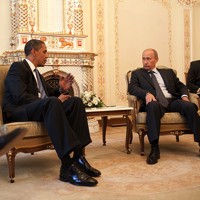The verdict is in: There will be no honeymoon for Barack Obama and Vladimir Putin. Many analysts were struck by the nonverbal cues in the two leaders’ body language after their first meeting on the sidelines of the G-20 summit in Los Cabos, Mexico, earlier this month. The era of close, warm interpersonal relations between Russian and American presidents, dating back to “Boris and Bill” in the 1990s, has officially come to a close.
With both Putin and Obama disinclined to even parrot the motions of friendship before the television cameras, an opportunity beckons to sweep away the “feel good” rhetoric about partnership -- often fueled by the bonhomie between the two chief executives -- that has dominated discussions of the U.S.-Russia relationship since the end of the Cold War. Instead, it may be possible to cement a more durable, lasting U.S.-Russia relationship, one that is based not on idealistic expectations, but instead on a series of limited, concrete deliverables.
Back in 2007, as a presidential candidate, Obama came to a sober evaluation of the U.S. relationship with Moscow: Russia was neither an enemy nor was it a close friend of the United States. This is not a comfortable position for American policymakers, who much prefer dealing with the black-and-white certainties that come from a state being either an opponent or an ally. Yet this ambiguity now accurately characterizes the U.S.-Russia relationship, and in crafting a response, Obama should embrace his earlier instincts about relations with Moscow.

